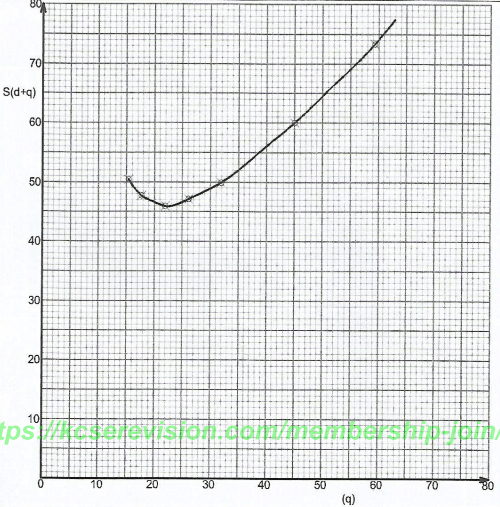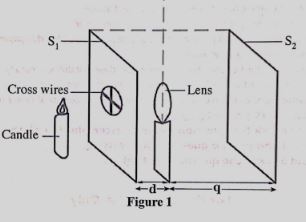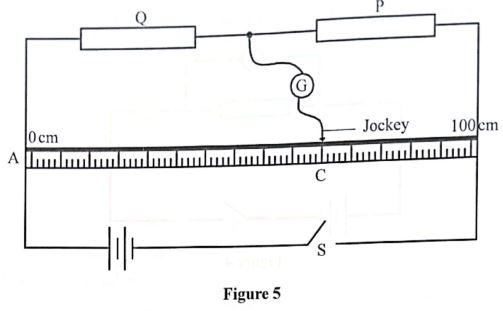QUESTION 1
You are provided with the following:
A metre rule A candle
A plain white screen labelled S,
A white screen with cross-wires labelled S,
A lens mounted on a lens holder
Proceed as follows:
PART A
-
- Arrange the candle, the screen S,, the lens and the plain screen S, in that order as shown in Figure 1.
- Light the candle. Ensure that the candle flame is close to the cross-wire and it is in a horizontal line with the centres of the lens and the screens.
- Arrange the candle, the screen S,, the lens and the plain screen S, in that order as shown in Figure 1.
- Set the distance d between the cross-wires and the lens at d = 16 cm. Adjust the distance q between the lens and the screen S2 so that a sharp image of the cross-wires is formed on Screen S2
- Record the distance q.
q....................cm (1mark) - Determine h given that: h=16q (2 marks)
9+16
- Record the distance q.
- Place screen S2 aside and adjust the position of the lens until a sharp image of the flame is formed on the screen beside the cross-wires.
- Measure the distance x between the screen S1 and the lens.
x=........................cm (1mark) - Determine r given that:r= xh (2marks)
x-h - Determine m given that: r/h =2(m-1) (1 mark)
- Measure the distance x between the screen S1 and the lens.
- Place the plain screen S, back to its original position as in Figure 1. Set the distance d between the cross-wires and the lens at d= 14 cm.
- Adjust the position of the plain screen S, to obtain a sharp image of the cross-wire. Measure the distance q between the image and the lens. Record the distance q in Table 1
- Repeat part (d)(i) for other values of d shown in table 1 and complete the table. (5marks)
Table 1d (cm) 14 15 18 21 24 30 35 q (cm) S=d+q (cm)
- Plot a graph of S (y-axis) against q. (5 marks)
- From the graph, determine the:
- minimum distance S, between the object and its real image (1 mark)
- focal length f given that: f = so/4 (1 mark)
- image distance v when S is minimum (1 mark)
QUESTION 2
- You are provided with the following:
- A piece of thread
- A metre rule
- A triangular glass prism
- A 50g mass
- A boss, a clamp and a stand
- Some water in a beaker
- Some tissue paper
- Liquid L
- An ammeter
- A voltmeter
- A wire labelled P
- A wire labelled Q
- A switch
- Two dry cells
- 9 connecting wires
- A wire mounted on a metre rule labelled AB
- A centre zero galvanometer
- A jockey
Proceed as follows:
PART A
- Using a piece of thread, a clamp and a stand, suspend the metre rule so that it balances horizontally about its centre of gravity.
- On the metre rule, suspend the glass prism at the 70cm mark and the 50g mass at a distance Xcm from the Centre of Gravity (CoG) so that the metre rule balances horizontally as shown in Figure 2.
- Record the balance length X.
X= ............................cm (1 mark) - Using the principle of moments, determine the mass Mo of the prism. (3 marks)
- Record the balance length X.
- While maintaining the position of the prism on the metre rule, lower the clamp to adjust the height of the prism until it is fully submerged in water as shown in Figure 3.
Ensure that the prism does not touch the sides of the beaker. - Adjust the distance X to restore the balance of the metre rule.
- Record the new balance length X,
X1 = ........................cm (1 mark) - Using the principle of moments, determine the apparent loss in mass M1 of the prism in water. (3 marks)
- Determine the value of a given that: M1 = M0 -µ (1 mark)
- State the quantity represented by μ. (1 mark)
- Record the new balance length X,
- Using tissue paper, dry the prism. Replace the water with liquid Z and repeat the procedure in part (c) and adjust the distance X to restore the balance of the metre rule.
- Record the new balance length X2.
X2 =........................cm (1 mark) - Given that X=RX1-SX2/R-S , where S 1000 kgm-3, determine the quantity R and state its SI unit. (3 marks)
- Record the new balance length X2.
PART B
- Use the apparatus provided to set up the circuit shown in Figure 4.
- Close the switch S.
- Read and record:
- Current I =.....................(A) (1mark)
- Voltage V= .....................(v) (1mark)
- Determine resistance of P. (1 mark)
- Disconnect the circuit in Figure 4 and use the apparatus to connect the circuit in Figure 5.
- Close the switch S. Using the jockey tap the wire AB at various points to obtain point C where the galvanometer shows zero deflection.
- Record the balance length AC = L
L= .............................cm (1 mark) - Determine the resistance of Q. Given thatQ/L =P/100-L . (2marks)
MARKING SCHEME
Question 1
(b) (i) q = 37.6cm ✓ (1)
(ii) h = 16q (2)
q+16
= 16 × 37.6 ✓
37.6+16
=11.22
(c) (i) x = 5cm✓
(ii) r = xh
x−h
= 5(11.22) ✓
5−11.22
= − 9.019
= −9.02 ✓
(iii) r/h =2(1−m)
−9.02 = (2−2m)
11.22
m = 1.402
m = 1.4 ✓
(d) (ii) Table 1
| d (cm) | 14 | 15 | 18 | 21 | 24 | 30 | 35 |
| q (cm) | 59.3 | 45 | 31.9 | 26.1 | 21.9 | 17.7 | 15.4 |
| S=d+q (cm) | 73.3 | 60 | 49.9 | 47.1 | 45.9 | 47.7 | 50.4 |
(e) 
(f) (i) So = minimum part of the graph
= 45.5cm✓
(ii) f = S0
4
= 45.5
4
= 11.375
= 11.4cm ✓
(iii) V is the value of q when S is minimum
V = 21.5cm ✓
Question 2
Part A
(b) (i) x = 26cm ✓
(ii) f1d1 = f2d2
20 × mo = 50 × 26 ✓
Mo = 50 × 26
20
= 65g ✓
(d) (i) X1 = 16cm ✓
(ii) 50 × 16 = M1 × 20 ✓
M1 = 50 × 16 ✓
20
M1 = 40g ✓
(iii) M1 = Mo − Mw
Mw = Mo − M1
= 65 − 40
= 25g ✓
(iv) μ = apparent loss in mass of prism ✓
(Do not accept upthrust)
(e) (i) X2 = 12.5cm ✓
(ii) X = RX1 − SX2 = 26 = R × 16 − 1000 × 12.5 ✓
R − S R − 1000
26P − 26000 = 16R − 12500 ✓
10R = 13500
R = 1350kg/m3 ✓
Part B
(h) (i) I = 0.42A ✓
(ii) V = 2.0V ✓
(i) RP = V/I
= 2.0
0.42
= 4.76Ω ✓
(l) AC = L ,= 38.9cm✓
(m) CB = 100 − l = 100 − 38.9 = 61.1cm 4.76✓
R = 4.76Ω
Q length 38.9cm
Q = P ⇒ Q = 4.76 × 38.9
38.9 61.6 61.1
= 3.03Ω ✓
Download PHYSICS Paper 3 Questions and Answers - KCSE 2022 Past Papers.
Tap Here to Download for 50/-
Get on WhatsApp for 50/-
Why download?
- ✔ To read offline at any time.
- ✔ To Print at your convenience
- ✔ Share Easily with Friends / Students





